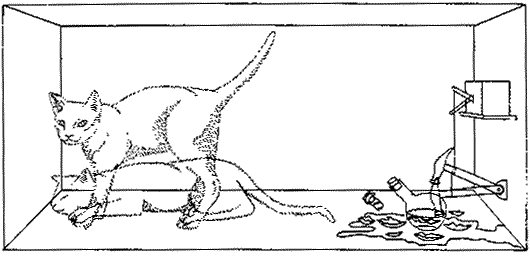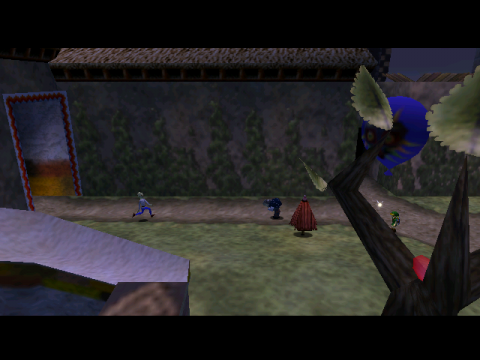
Video games certainly aren’t shy about their fascination with time travel. Many hinge their entire narratives around the idea, and those that do are often forced to include a number of different outcomes to avoid any paradoxes that might arise from it. Majora’s Mask is no different in this regard, as the idea of time travel is inextricably entwined with its plot and its gameplay. Despite this commonality, however, its implementation and function within the grander scheme of the game more closely resembles the many-worlds theory than it does the traditional notion of time travel (at least, as it has been interpreted by other games), and the title and all of the situations therein take on a decidedly different character when they are viewed through this new lens.
In short, the many-worlds theory posits that every possible outcome to a situation occurs in its own separate, “parallel” universe. To put it more simply, if I were to, say, flip a coin, both potential outcomes would be realized: in one universe the coin would land on heads, while in a parallel one, the coin would land on tails. In effect, this event would act like a branch point, and from it would stem two equally real but decoherent results. Because of this, no event in the world would truly be random; each possibility would be accounted for despite our not being able to witness it.
This theory has been used as a possible explanation for the famous thought experiment and paradox known as “Schrödinger’s Cat”. In the hypothetical scenario, a cat is placed in a sealed container alongside a flask of poison and a Geiger counter (in which would be a small radioactive substance). If there should be some radioactive decay within the course of an hour (the length of the substance’s half-life), then the counter will trigger a hammer which will shatter the flask and kill the cat; if there is no decay, then the hammer will remain in place and the cat will live. According to the Copenhagen interpretation of quantum mechanics (to which the experiment was initially a response), after the allotted time the cat is fifty percent alive and fifty percent dead, but if we were to actually peer into the container, the cat could only be one or the other, not both. The many-worlds theory reconciles this paradox by presenting a scenario in which the two outcomes are equally real despite only one being apparent: the cat would be alive in one universe and dead in another. The Copenhagen interpretation thus holds true even though we would only perceive one of the potential results as coming to fruition.

With this in mind, it is easy to see how the many-worlds theory can be applied to Majora’s Mask, specifically the way in which the game depicts time travel. Link is given a mere seventy-two hours to rescue Termina from its fate, but there is far too much to be done within that time limit for everything to be accomplished. At the end of the third day, the player has no choice but to play the Song of Time and begin the entire cycle anew, returning the land to the exact state as when Link first set foot in it. Because of this, the player is free to tackle other challenges he or she was not able to in the previous time stream, and a different chain of events will unfold despite the scenarios beginning in exactly the same way.
This is most apparent with regard to the plight of Termina’s inhabitants. Take, for instance, the elderly woman from Clock Town’s bomb shop. At approximately midnight on the first day, she will be robbed of her shipment of bomb bags as she passes through the city’s northernmost district. Despite the certainty of this event, there are a number of possible outcomes to it depending upon the player’s actions: Link can simply be elsewhere when the robbery occurs, leaving the old woman to be assaulted; he can attempt to thwart the thief but ultimately fail, resulting in the merchandise still being stolen; he can successfully prevent the robbery and allow the shop to stock the new item; or he can outright kill the thief (with a well-placed arrow), removing him completely from the world for the remaining two days (and preventing Kafei from retrieving his stolen mask in a separate-but-interrelated side quest). Each outcome has a different bearing on the events that follow, but only a single one can ever occur per time stream. Given the nature of the game, however, it is likely the player will experience several (if not all) of these possibilities in his or her various play-throughs. Like in Schrödinger’s thought experiment, every outcome to this situation does indeed unfold, but it only does so in its own separate time stream; thus, through the player’s own efforts, the title emulates the many-worlds theory.

This reading of the game would explain why Link is able to keep the remains of the bosses he defeats despite traveling back to before he even challenges them, not to mention all of the items he acquires throughout the course of his adventure. It seems that, by playing the Song of Time, Link does not rewind time so much as he jumps to a parallel universe, one that is identical to the previous in every way save for the manner in which certain events will unfold. This is why none of the characters he encounters recognize him even though he keeps all of the rewards he’s earned for assisting them– the items he obtains serve as proof that each time stream he creates is as real as the previous one, and all of the people he meets, despite being identical to those he’s already helped, are in actuality their own unique beings.
This in itself is certainly an interesting take on the title, but far more intriguing are its implications on the story at large. If Link does indeed jump to a different universe each time he plays the Song of Time, then he effectively abandons the previous one. This would mean each time he returns to the first day, he is actually leaving one world and entering another. The previous universe will continue on in his absence until the moon careens out of orbit and obliterates it in a fiery cataclysm, and this will continue to happen ad infinitum until Link is finally able to halt the errant satellite’s suicidal descent. Thus, despite the player’s best efforts, Termina is doomed to be destroyed countless times during the course of the game because it is simply impossible to clear every dungeon and assist every character within a single time stream. Link, charged with such a Herculean task, will fail to save the world many times over before he finally succeeds, and each Termina that is destroyed is just as real as the one that is ultimately spared. For the first time in the history of the franchise, Link, the infallible hero who rises to meet whatever danger befalls the world, not only fails to prevent its destruction, but does so a number of times. While he himself is spared from this continual apocalypse thanks to the magic of the Song of Time, the people in his care are left to meet their demise.
This, of course, is all just entertaining conjecture, but it certainly puts an interesting spin on the events of Majora’s Mask. The game is unlike any other in its portrayal of time travel, and that it so closely resembles the many-worlds theory adds a metaphysical depth to the narrative few other titles are able to achieve. It also puts a greater emphasis on the impossible burden of being a hero, revealing the stark and oft unspoken reality that not everyone can be saved all the time. While this interpretation only makes the proceedings within the title seem even grimmer than they originally appear, it also adds a palpable sense of weight to all of Link’s (and, by extenstion, the player’s) decisions. Just think, the next time you play the Song of Time, you may as well be sounding a knell for all of the hapless lives you are abandoning to their death.




 ShareThis
ShareThis







I think that when Link plays the Song of Time, he travels back in time and then travels to a parallel universe, or maybe the other way around. The many-worlds theory has been seen as a way to solve several time paradoxes that are always present in any form of time travel. If Link just traveled back in time to the start of the cycle, then that means that there would be 2 Links at the start of that cycle, which introduces all sorts of problems. As such, the many-worlds theory can be used to simplify this form of time travel and avoid all of those nasty time paradoxes that could destroy the space-time continuum, even if it is only a virtual space-time continuum.
And on a side-note, I had no idea that you could actually kill the thief with an arrow. Might have to try that out one of these days.
I didn’t know about it either until I read it online somewhere. XD
There’s a video of it up on YouTube: http://www.youtube.com/watch?v=f-MzlJYg-Us
I found this article really interesting, not least because I like the Shrodinger’s Cat theory! It’s a surprisingly good conversation starter.
On a separate note, I’d be more interested in actually getting to play Majora’s Mask. While Ocarina appeared alongside Wind Waker, in the compilation and now on 3DS, Majora’s Mask seem relatively unloved. I know I could play it on Virtual Console but I have issues with that the classic controller. Deep issues.
Playing OOT 3D really makes me hope there will be a Majora’s Mask remake as well.
I can certainly sympathize with your Classic Controller issues, but I think you should experience the game any way you possibly can. It’s very different from every other Zelda title, but I think that just adds to its appeal. It might not have the same impact on you as it did on me considering how much technology has progressed since it was released, but I think it still holds up remarkably well despite its age, even with N64 graphics.
I love this kind of stuff in video games where there are interesting, sometimes dark truths.